Gender identity is a person's internal, deeply held sense of their own gender (or lack thereof). Unlike gender expression, gender identity is not visible to others. An individual's gender identity may or may not align with their birth assignment.[1][2] Most people, whether cisgender or transgender, have a gender identity of male/man/boy or female/woman/girl. For other people, their gender identity does not fit neatly into one of those two options, such as people who are non-binary or genderqueer.[1]
Examples of gender identities
Agender
- Main article: Agender
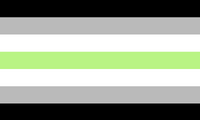
The agender pride flag
Agender, also known as genderless,[3][4][5] can be one of the A terms in the acronym LGBTQIA+.[3][4] It is a gender identity that has been defined multiple ways, including:[5]
While agender is typically considered under the transgender and/or non-binary umbrellas, different individuals may or may not identify with those terms; those who do use them do not need to transition physically, legally, or socially to be agender.[4][6] Some agender people are genderfluid, meaning their gender identity is not static and changes from being agender.[4] Agender individuals can have any type of gender expression and use any set of pronouns or no pronouns at all just like any other individual can.[7] Agender identities are not exclusive to certain assigned genders at birth or sexual orientations and romantic orientations[8] and the orientation terms used by individuals who are agender may potentially challenge the idea of "same" and "opposite" gender attraction.[4]
Bigender
- Main article: Bigender
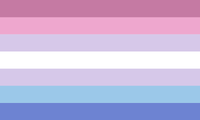
The bigender pride flag
Bigender is a gender identity in which a person has or experiences two genders. The genders may be any combination of two genders, and those genders can be binary ("man" or "woman") or non-binary. They may be experienced simultaneously or may alternate, and they may not be experienced equally or in the same way. For example, a bigender person may be both a woman and a man, agender and neutrois, or non-binary and a woman.[5] Bigender is an identity under the transgender umbrella.[4]
Demigender
- Main article: Demigender
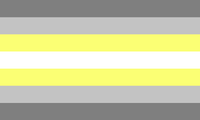
The demigender pride flag
Demigender is an umbrella term for non-binary gender identities that feel a partial, but not full, connection to a particular gender. Anyone can be demigender regardless of what gender they were assigned at birth, and demigender individuals may identify as another gender in combination with their demigender identity.[9]
Genderfluid
- Main article: Genderfluid
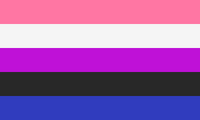
A genderfluid pride flag
Genderfluid, or simply fluid, refers to someone whose gender identity changes over time. A genderfluid individual can identify as any gender, or combination of genders, at any given time. Their gender can change at random, or it may vary in response to different circumstances. At times, these individuals may identify as male, female, both, or neither.[10] Their pronouns may vary at different times. The term genderfluid can be used as a specific identity in itself or as a descriptive term. They are generally considered under the non-binary and transgender umbrellas, but not all genderfluid individuals identify with those terms. Some genderfluid people transition socially, physically, and/or legally.[11]
Genderqueer
- Main article: Genderqueer
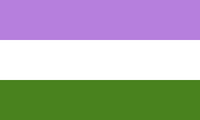
A genderqueer pride flag
Genderqueer is a gender identity that is neither male nor female, is a combination of the two binary genders, is on a continuum between those two genders, or queers gender in some way. Both genderqueer and non-binary can be seen as umbrella terms or as more specific identifiers.[12] Some, but not all, genderqueer people identify as transgender.[13]
Neurogender
- Main article: Neurogender
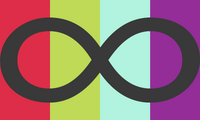
The neurogender pride flag
Neurogender identity was originally proposed as "a gender feeling that is strongly linked to one's status as neurodivergent".[14] It was further elaborated upon as the following: "Neurogender is a gender feeling that is linked to someone's neurodivergence. It can be both an identity and an umbrella term for genders that are limited to neurodivergent people. Obviously, you have to be neurodivergent to identify as this gender. And no, it is not 'turning neurological disorders into a gender'. Neurogender just means that a person's perception of their gender is influenced by them being neurodivergent."[15] As the meaning of the term "neurodivergent" has been debated, it is unclear which definition was intended.[note 1]
By 2016, "neurogender" had been redefined by others as "an umbrella term to describe when someone's gender is somehow linked to their neurotype, mental illness, or neurological conditions. There are many different neurogenders related to most, if not all, neurodivergencies."[16] This specific redefinition has been cited in at least one print source.[17] In another redefinition from 2018, neurogenders were described as "genders specific to neurodivergent people whose experience of gender relates to their neurotype or who feel they can't fully understand gender due to their neurotype."[18]
Neutrois
- Main article: Neutrois
Neutrois is a non-binary gender identity described as being a neutral or null gender.[19] It is considered part of the genderqueer, non-binary, and transgender umbrellas.[20][21]
Non-binary
- Main article: Non-binary
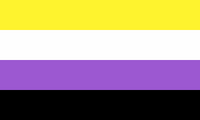
The non-binary pride flag
Non-binary, sometimes written as nonbinary, is a term referring to individuals whose gender identity does not exclusively fall into the binary gender classification of only "man" or "woman." Those who are non-binary may identify with either masculinity or femininity in some capacity, both, or neither at all.[1] Although it is a gender identity on its own, it can also be used as an umbrella term to refer to many gender identities.[22] While non-binary is included in the transgender umbrella, not all non-binary people identify as transgender.[23]
Since identifying as non-binary can mean different things to different people, it is best to ask someone who uses the term what it means to them.[22]
Queer
- Main article: Queer
Queer is an identifier for individuals and/or the community of people who are not cisgender and/or heterosexual.[24][25] It can be used instead of, or in addition to, other identifiers of sexual orientation, such as lesbian, bisexual, or gay. Queer can also refer to gender identity or gender expression,[24] whether as a standalone term or part of another like genderqueer.[26] The "Q" in LGBTQIA+ and similar acronyms commonly means Queer.[24] As a reclaimed word, it has been used in fights for LGBTQIA+ rights and liberation[27] as an inclusive and sometimes defiant term. PFLAG[25] and GLAAD[24] are two of the organizations that recommend only using it for people who self-identify as queer because it has varying meanings and is not universally accepted.[24][25] In addition, the term may be used in preference to other identifiers by members, for a variety of reasons.[28]
Xenogender
- Main article: Xenogender
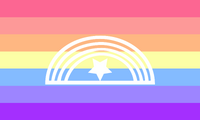
The xenogender pride flag
Xenogender is defined as "a gender that cannot be contained by human understandings of gender; more concerned with crafting other methods of gender categorization and hierarchy such as those relating to animals, plants, or other creatures/things".[29] Xenogender individuals may use ideas and identities outside of the gender binary to describe themselves and avoid binary gendered identifiers, such as using only their first name or the name of an animal.[30] They may feel they cannot place a label on themselves,[31] or feel as though they lack the terms to fully express their gender or identity, something that derives from a lexical gap.[note 2][33] The term "xenogender" itself was designed to help fill the lexical gap by using terms not typically associated with gender or describing gender with metaphors.[33] Since it is a gender identity that is outside the binary concepts of masculinity and femininity, xenogender is a non-binary identity.[30]
See also
Notes
- ↑ Neurodivergent is a term associated with the neurodiversity movement. Neurodiverse, coined by Judy Singer, is not equivalent to "neurological disorder" or "autistic"; an individual person is not neurodiverse. Neurodiversity is comparable to biodiversity and refers to the neuro-cognitive variability found in all humans, such as mood, learning, attention, social behavior, and other mental traits. The neurodiversity movement is primarily associated with people who are on the autism spectrum, as well as "cousin" conditions such as attention deficit/hyperactivity disorder, intellectual disabilities, learning disorders such as dyslexia, and motor disorders such as dyspraxia and Tourette's Syndrome. The term neurodivergent, coined by Kassiane Asasumasu, refers to neurologically divergent from typical or a brain that diverges. Asasumasu has said it is not limited to neurodevelopmental disorders and includes people with mental illnesses or no specific diagnosis. Others have redefined neurodivergent as specific to neurodevelopmental or neurological conditions, and not mood, dissociative, or personality disorders. Further explanations of neurodiversity versus neurodivergence are available on the Neuroqueer blog.
- ↑ A lexical gap is a word that does not exist in a particular language, although it could exist according to that language's rules.[32]
References
|
